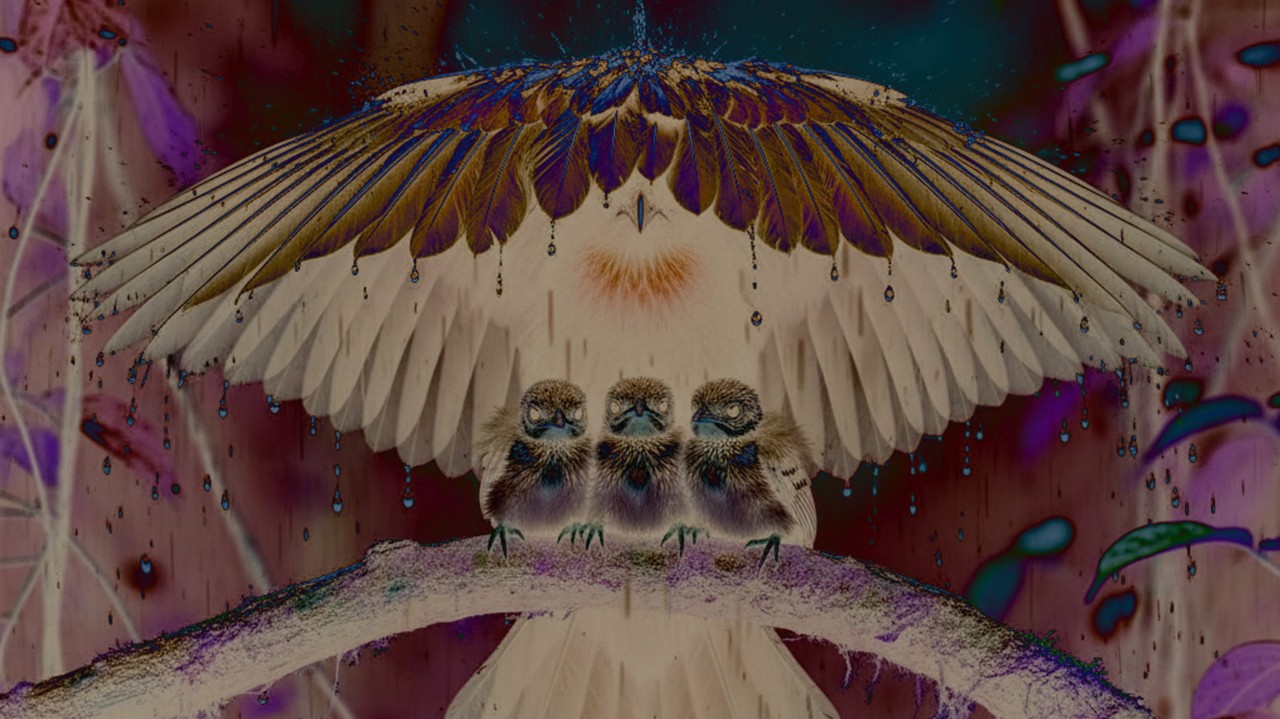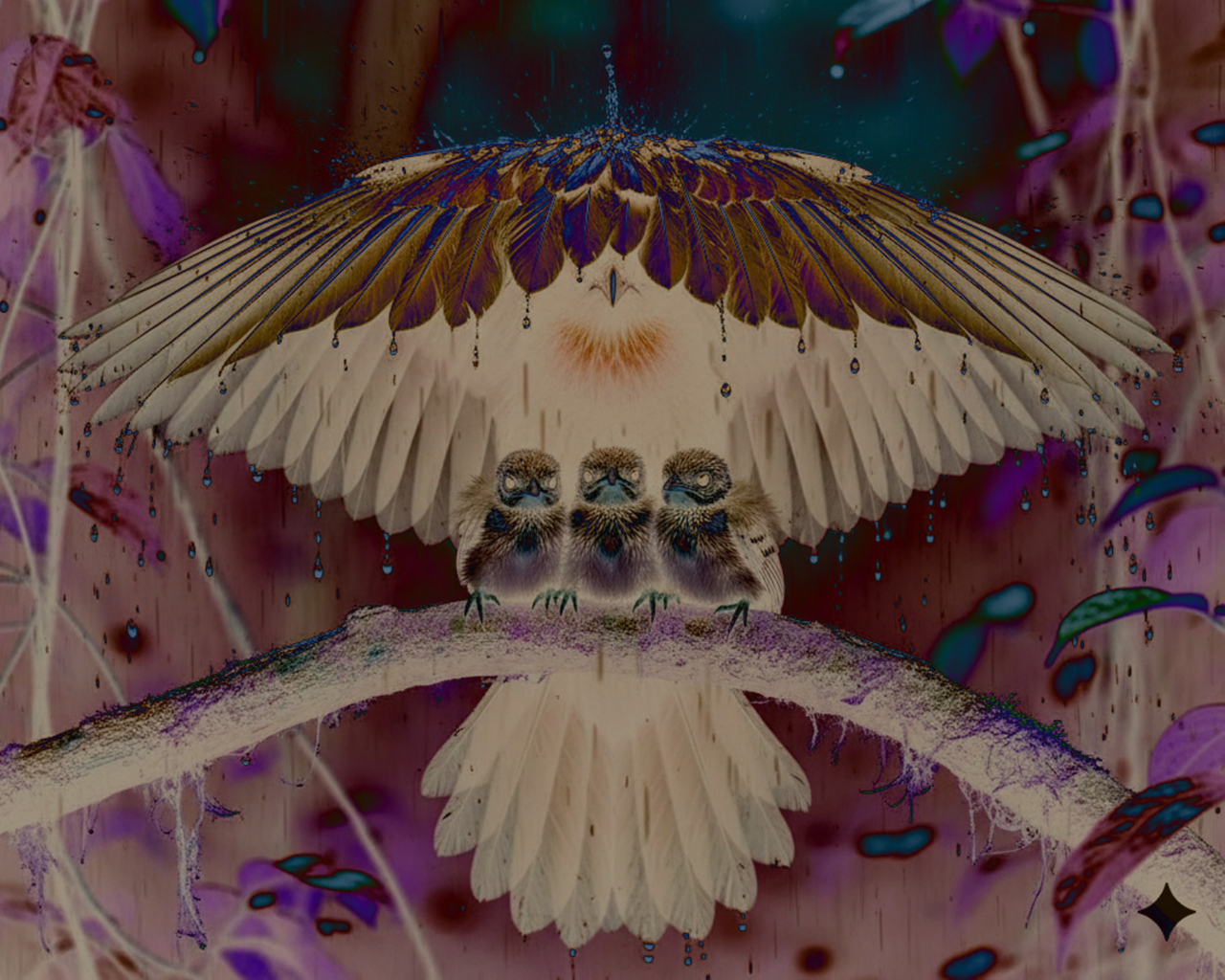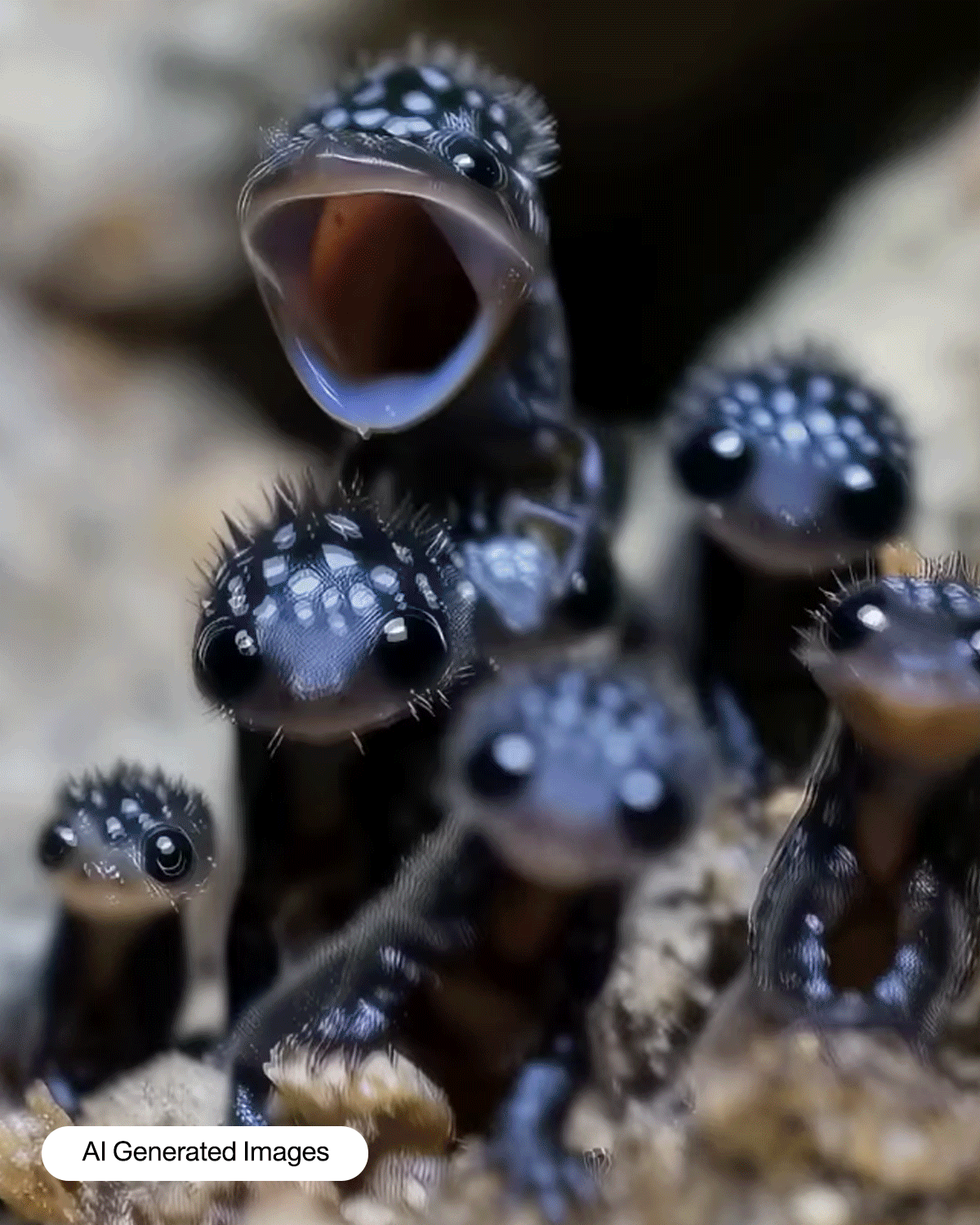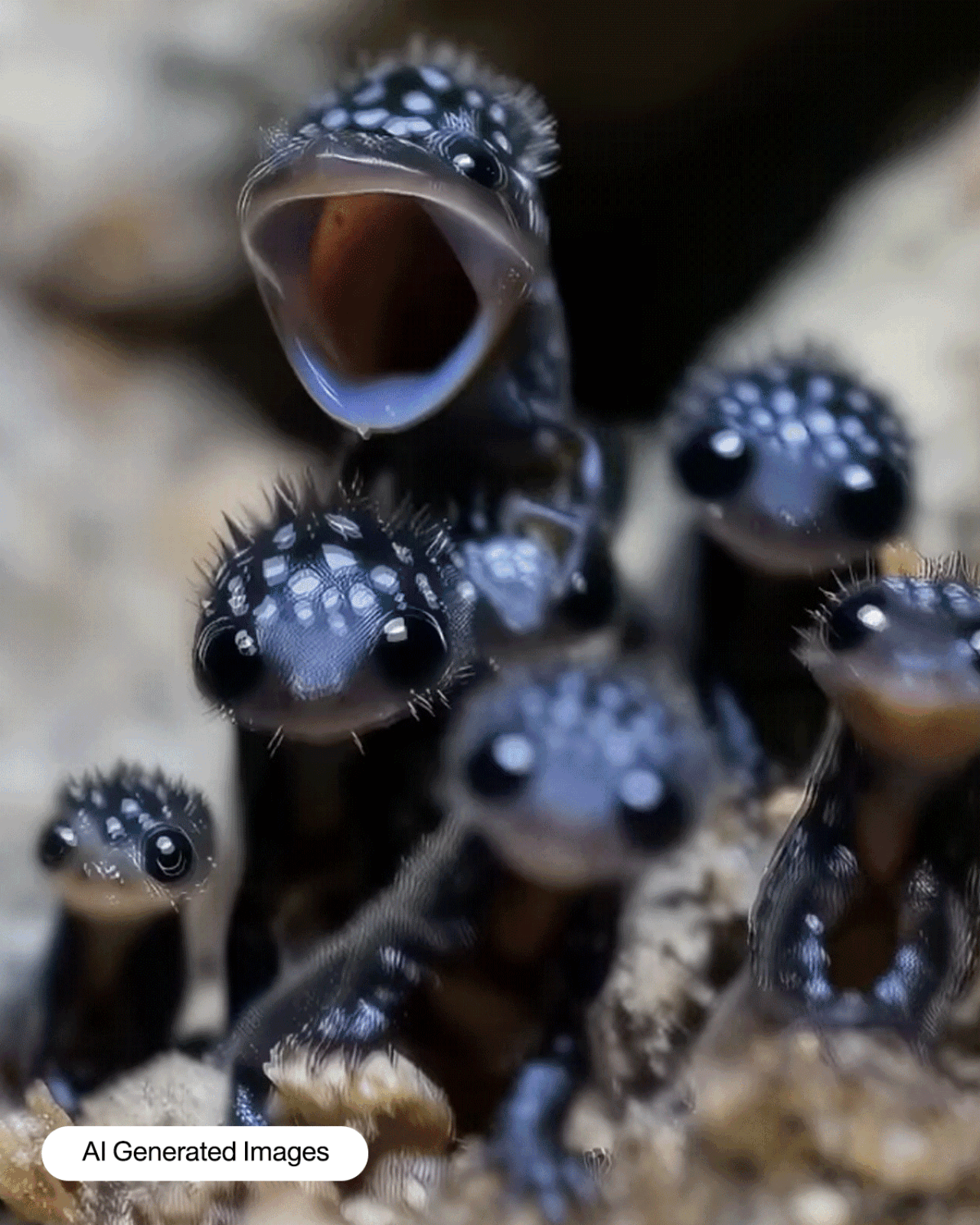

words by katarina zimmer
artwork by atmos
If your social media feeds are anything like mine, they’re littered with AI-generated images. One video depicts a hummingbird couple sheltering from the rain inside a rose; in another, a polar bear cub is “rescued” from an icy ocean, playfully and gratefully interacting with its human saviors. AI has even fashioned new animals altogether, including salamander-like “amphiblet” creatures with big, black, adorable eyes.
AI-generated content is only becoming easier, faster, and cheaper to make. With tools such as OpenAI’s Sora, Google’s Gemini, or Meta’s video generator, creators can craft wildlife images and videos from word prompts and post them on social media en masse, where some posts have racked up millions of likes. This imagery often contains startling levels of detail and realism—so much so, in fact, that many commenters don’t seem to recognize it’s fake. In reality, no hummingbird nests inside flowers, polar bears don’t need “rescuing” from their natural habitat, and “amphiblets” don’t exist.
That worries some experts, who have come to see such portrayals as a new and potentially dangerous breed of misinformation. While fake news about wildlife might seem relatively harmless compared to, say, deep fake videos of politicians that could sway election results, scientists say that inaccurate portrayals of animals could have far-reaching implications for people and their relationship with wildlife—and that more should be done to clearly label AI content. Otherwise, such imagery may worsen the already-poor understanding among many urban Western societies about wild animals and their habitats, behaviors, and needs. At the worst, these misrepresentations could even harm the conservation of animals, change how we interact with them, and erode people’s general interest in nature.
“There’s a lot of good, objective reasons to feel uncomfortable about it,” said Andrew Gosler, an ethnoornithologist at Oxford University in the U.K.
Creators have many motivations for making AI visuals. Some are inspired by the prospect of producing content that goes viral, which can benefit creators financially via rewards programs like TikTok’s that pay for widely-viewed videos, and help them get more followers and engagement. But often, says Numan Khan, a U.K.-based digital creative, it’s simply about showcasing creative skills, the joy of making unusual imagery featuring beloved creatures, or even testing the public’s ability to recognize such videos as AI-generated. “I purposely make my videos in a way that they look like they’re recorded off a phone,” Khan said. “It’s purposely done that way to make it look a bit more realistic.”
Some AI-generated wildlife videos might have positive outcomes, such as sparking curiosity about the natural world or increasing interest in conserving threatened animal populations. Jenny Vermilya, a sociologist who studies animal-human relationships at the University of Colorado Denver, speculates that videos depicting polar bears as fuzzy, warmhearted creatures, for instance, could foster compassion for the endangered animals.
“Misrepresenting animals’ behaviors or environments can distort people’s understanding of where animals truly belong and how important they are to their ecosystems.”
But Vermilya and other experts are more worried about negative impacts. Some research suggests that just seeing lots of images of a certain species—even in the form of children’s toys or commercials—can give the impression that these animals are more abundant than they actually are. That’s a problem when, as is the case with many of the AI-generated bird videos, social media content depicts endangered animals—creatures in dire need of conservation attention—living plentiful lives. Gosler recalls a video showing a threatened tropical bird using its wings as an umbrella to shield its young from the rain, evoking a warm, fuzzy sense that all is well with that species. “I think that’s probably one of the biggest issues—that it gives the impression that actually the environmental messages are less serious than they actually are,” Gosler said. At its extreme, this could lead to fewer donations and volunteer efforts toward conserving species.
Another concern is that people will believe the inaccurate details such videos contain. Even the most ridiculous concoctions, such as a Facebook video featuring a man reviving a dead robin by dunking the bird in a bucket of water, attract comments suggesting the images are real; in the case of the robin video, Gosler recalls, viewers praised the man’s kindness. (Needless to say, “You can’t revive dead robins by immersing them in water,” Gosler said.) People are generally more prone to believing misinformation when they see it in the form of videos, according to misinformation and generative AI expert Jevin West of the University of Washington, who co-founded the Center for an Informed Public. “Even if you almost know they’re fake, it’s hard to dislodge yourself from them not being real,” West said.
People in many urban Western societies may be more easily duped because they already know so little about wildlife. In a yet-unpublished survey of roughly 1,000 Spanish preschool and elementary school students, biologists José Guerrero Casado and Tamara Murillo Jiménez at Spain’s Universidad de Córdoba found that the children had surprisingly poor knowledge about animals, and especially native species; many didn’t know that zebras and tigers are not native to Spain or that wild rabbits don’t actually eat carrots. And in 2021, Gosler found similarly poor ecological knowledge in a survey of 149 first-year biology students at Oxford: only 55.7% could name five species of local British birds. “They’re so disconnected from nature,” Gosler lamented.

AI-generated imagery could further distort people’s knowledge of animals in numerous ways. Vermilya, for instance, is worried about the many AI-generated videos showing animals with humanlike behaviors and feelings. Studies on children who read books featuring anthropomorphized animal characters suggest that, while such depictions can boost empathy and compassion toward animals, they can also lead young people to believe that animals are more humanlike than they actually are. Portraying animals such as bears as cuddly and friendly creatures could even be dangerous, since people may be more inclined to seek out such animals in the wild, Vermilya cautions. “I’m near the Rocky Mountains, and there’s a … long history of people going off into the mountains and wanting to interact with wild animals and getting mauled,” she said.
Conversely, AI-generated imagery of predatory animals violently attacking humans or livestock, or evil-seeming snakes hunting a bird’s young chicks, for instance, could create unnecessary levels of fear toward a species and lead people to believe certain animals are less deserving of conservation attention, even if they’re endangered. “If you interpret that the snake is a bad animal—as a devil—and the chicks and the bird are good animals, [then it seems that] we have to conserve the bird but not the snake,” said Casado, who, together with Jiménez, wrote an article published in September about the risks of AI-generated wildlife videos.
Misrepresenting animals’ behaviors or environments can distort people’s understanding of where animals truly belong and how important they are to their ecosystems. “That can lead to, say, the decision-making around, well, ‘How do I think about that animal? Do I support organizations that help that animal? Do I go and visit that animal in that space? Do I eat that animal?’” Vermilya said. A video showing a capybara, a South American rodent, in a bathtub, for instance, could boost people’s interest in keeping such animals as pets and fuel the illegal trade of such species, Jiménez says.
Images of animals that don’t exist at all, like hybrids of hippos and lizards, could cause confusion among children and young people whose critical thinking skills haven’t yet developed. “This is a real problem now,” Jiménez said of young people spending much of their time online and indoors, far from natural environments. “They think the things that they’re seeing in their phones … is reality.”
There’s also risk to people finding out certain AI-generated imagery is fake, West says, as doing so can make it harder to trust accurate depictions, including photos and videos taken by professional wildlife photographers who may spend months working to get a shot of a rare species or by scientists to document an animal-related scientific discovery. “What if we did see a hummingbird in some interesting situation, and we’ll just think, ‘Oh, it’s a deep fake,’ when, in fact, it might actually be real?” West asked. “Then we’ve lost the opportunity to be excited about biology.”
“At its extreme, this could lead to a widespread apathy toward nature, alienating us even further from the natural world at a time when wildlife needs our attention the most. “
At its extreme, this could lead to a widespread apathy toward nature, alienating us even further from the natural world at a time when wildlife needs our attention the most.
Experts agree the solution is not to banish such content altogether, but to ensure it is clearly labeled as AI-generated. To that end, the European Union in September introduced legislation requiring companies to label any AI-crafted material as such, beginning in August 2026. Platforms including TikTok, Facebook, and Instagram give creators the ability to label their posts as AI-generated, while many creators also use #ai hashtags in their posts or explicitly state on their profiles that they make AI-generated content. And last year, Meta started using technology to automatically detect and label AI-generated content with an “AI Info” label.
But many AI-generated videos still don’t contain such labels. Daniel Roberts, a spokesperson for Meta, said it’s not possible to label every AI-generated post on its platforms because many AI tools don’t add the kinds of signals allowing for easy detection of AI-made material, and people find ways to remove or hide such signals. “We’re continuously working to improve our systems and ability to label this content,” the Meta spokesperson said. (TikTok’s public relations team did not respond by deadline to a request for comment.)
Even when labels do appear, they can be easily overlooked. On Instagram, for example, such markers appear as small “AI info” icons in the top-left corner of a video. “I agree Instagram should make an effort to make it a bit more visible,” Khan said. In his view, platform users should do their research to determine if content is AI-generated—including scrutinizing the video for unnatural-seeming details and examining the account posting it to determine whether they post other AI-generated content.
Until greater action is taken on the issue, exercising caution around such imagery may very well be our only option. Jiménez and Casado suggest that, should you see an animal video that you doubt the authenticity of, you use it as an opportunity to seek out credible professional wildlife photographers, news websites, nature documentaries, conservation non-profit news websites, or science journalists to learn real information about the animal in question.
“I think that consumers just have to be a little bit more careful about what they see on social media,” West said. “Reading some of the news of professional journalists, I think, is more reliable, of course, than anything you see on social media.”
AI-Generated Animals Are Distancing Us From Nature
